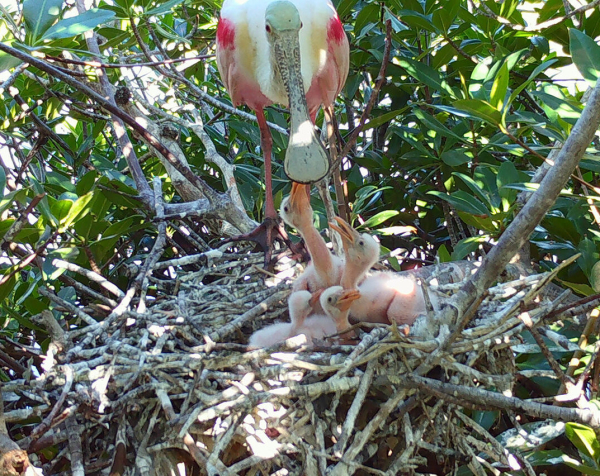
The movements of Roseate Spoonbills in the Everglades are being monitored using cellular tracking devices (photo by Paul Konrad).

A trail camera photo provided a record of an adult Roseate Spoonbill’s return to its nest to feed its nestlings (photo by the Everglades Science Center).
|
Biologists at Audubon’s Everglades Science Center (ESC) recently piloted a new initiative to collect data using satellite transmitters and trail cameras to better understand Roseate Spoonbill behavior in Florida Bay. The new Roseate Spoonbill study has three key elements: 1) tracking adult birds to learn more about their movements; 2) conducting surveys and monitoring nesting colonies in Florida Bay during the nesting season to collect nesting data and population information; 3) advocating for significant public policy changes.
The ESC has been studying Roseate Spoonbills since 1939, starting with work by Audubon’s first director of research, the famed Robert Porter Allen. “Understanding spoonbills’ behavior gives us clues about changes in water quality and quantity in the Everglades,” said Audubon Florida’s current director of research, Jerry Lorenz. “Spoonbills can also provide warning signals for upcoming changes or shifts to an ecosystem, including rising sea levels.” Dr. Lorenz’s ongoing research already shows that Roseate Spoonbills are shifting their nesting sites in direct response to habitat destruction and climate change.
Trail cameras with motion sensors are now capturing information that complements other information sources while minimizing disturbance to active nesting colonies. The cameras can document information in locations where it is difficult for biologists to access the nests, and at times when it is best not to disturb the birds, enabling a more comprehensive look at these nesting Roseate Spoonbills. ESC staff plans to install as many as 50 trail cameras at nest sites in Florida Bay in 2021, and information collected during this study will help guide decision-makers as they consider water management and restoration plans to improve habitats for spoonbills and other wildlife.
Recently, ESC staff piloted a new technique to track the movements of Roseate Spoonbills. During 2020, biologists captured 10 adult spoonbills in Florida Bay to attach cellular tracking devices. These birds are already providing information their feeding preferences, and are currently using more ponds inside keys in Florida Bay rather than the mangrove wetlands on the mainland that they historically preferred. Tracking information also shows interesting flight patterns that provide clues about where spoonbills are going outside the nesting season, and when they are moving to these different areas.
This use of the new technology will enhance ongoing efforts to understand the effects of climate change, sea-level rise, and Everglades restoration efforts on these charismatic Florida birds.
The combination of using trail cameras and satellite tracking not only provides biologists with important clues to their survival, but also offers an opportunity to share Audubon’s research with a broader audience and connect more people with this ongoing work.
To refer to the original article about tracking Florida’s Roseate Spoonbills, see https://fl.audubon.org/news/audubons-everglades-science-center-uses-new-technology-track-roseate-spoonbills
For more information about Audubon’s Everglades Science Center, see https://fl.audubon.org/chapters-centers/audubons-everglades-science-center